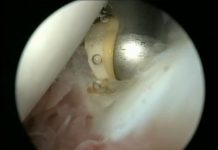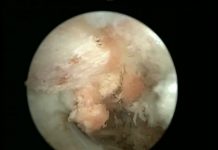WHY DO WE NEED RADILOGICAL EXAMINATIONS?
During the staging process, physical examination findings, laboratory tests and radiological diagnose methods are used together. The information acquired in each stage is highly important and complementary. For example, the detection of electrification feeling on a big mass in the palm is an important finding indicating that the mass is originating from nerve tissue ad growing by involving the nerve tissue (figure 5).
Figure 5. The Archive of Hakan Gündeş Lipoma tumor in the palm.
While the progress of the mass through the soft tissue can be detected with MR (magnetic resonance), whether it has given any harm to the bone tissue can only be understood with CT (computerised tomograph) (figure 6).
Figure 6. The Archive of Hakan Gündeş
The MRI and CT examinations of the bone tumor on the wrist. While the CT can provide information about the destruction on the bone, MRI examination can give better information about the soft tissue.
In summary, the information acquired upon the history and physical examination findings can direct your doctor to have some examinations. The below given examinations are not routinely required for every patient.












